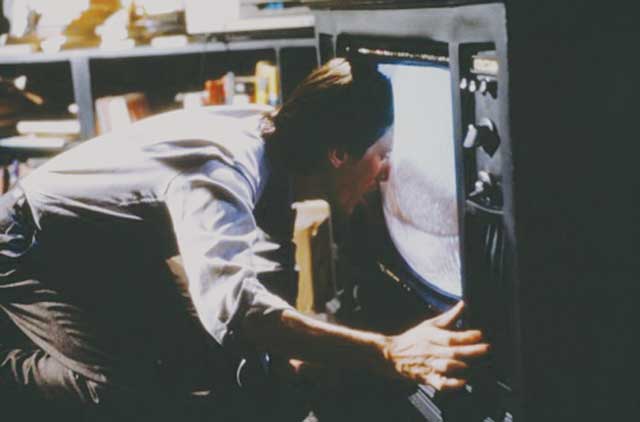Nobody makes horror films like the Canadian taxpayer
Kier-la Janisse | Thursday 17 May, 2012 15:02

Canuxploitation fans rejoice! On Sunday, 20 May at the Roxy Bar and Screen, the newly-inaugurated Shivers Film Society launches its first in a screening series devoted to Canadian genre cinema, with an all-day marathon of indie films from the last decade and capped off with a screening of David Cronenberg’s seminal Videodrome (1983). Don’t consider yourself a Canadian B-film aficionado? You probably are more than you know.
“The mandate [of the organization] is to illicit an appreciation of Canadian films by audiences and a sense of national pride from contemporary indie Canadian filmmakers by revealing the strong influence, cultural relevance, and cinematic history in the story of Canadian cinema, and cinema production,” says Vince D’Amato of Vancouver’s Creepy Six Films, who first hatched the idea for Shivers when he was living in London last year. “London is a city rife with film societies and has a phenomenal cinema culture unlike anything I’ve experienced,” he continues, “and I was inspired to begin screening films from our own production catalogue there in the city.” Although he’s now back in Vancouver, his partners Justin Harries from Filmbar ’70 and Scala Forever, and Nadeem Ali from Videotape Swapshop will be running the London-based events, while D’Amato focuses on setting up similar screenings on Canadian soil.
With the event bearing the tagline ‘The Influence of the Canadian Tax Shelter Films’, it’s probably important to know what tax shelter films are. While the term has gained some cachet in recent years, many people are still foggy on the details, so simply put, the Tax Shelter Era refers to the period between 1974-1982 when the Canadian Film Development Corporation gave investors in Canadian filmmaking a 100% capital cost allowance, as a means of encouraging national production. The term sometimes extends to films made through the late 1980s, as there was still a 50% tax break, but by 1990 it had dropped back to roughly 30% and the tax shelter era was officially over.
But this period was about more than economics – many people think of the tax shelter as an ethos, a ‘golden era’ of unprecedented freedom from stifling nationalist mandates. It was, for better or for worse, a cinematic free-for-all. The founding of the Canadian Film Development Corporation (or CFDC) in 1967, a federal initiative to create a self-sufficient film industry outside of documentary and experimental animation (what Canada was primarily known for, via the NFB) was especially seized upon in Quiet Revolution-era Quebec, which was enjoying an exciting cultural and political overhaul. It was in this context that Canuxploitation pioneers Andre Link and (the late) John Dunning were able to turn their distribution company Cinepix into a production house, which ushered in Quebec’s wave of ‘maple syrup porn’ (a term coined by Variety but adopted into the Canadian vernacular) with Denis Héroux’ Valérie (1969) and L’Initiation (1970). Countercultural softcore films and sexy satires proliferated in their wake, from lowball sex comedies like Après Ski (1971) to campy spy capers like 1972’s IXE-13 (‘The French Canadian Dream!’). By the early 70s, Cinepix – like their counterparts Quadrant, Astral Bellevue Pathé and Cineplex – turned to horror as the next wave, which gave a start to directors like George Mihalka (My Bloody Valentine), William Fruet (Death Weekend), Bob Clark (Black Christmas) and David Cronenberg (Shivers), who all benefited from the tax breaks that were by then in place. While many of these directors didn’t necessarily see themselves as aligned with the genre per se (Fruet for example was best known for penning Don Shebib’s 1970 CanCon classic Goin’ Down the Road), the tax shelter program allowed them find a way to marry their more heady aspirations to the exploitation ethos.
During the tax shelter era, Canada was actually out-producing Hollywood, but that doesn’t mean the films were lapping up awards. The tendency of the tax shelter pictures toward exploitation fare elicited the ire of Robert Fulford of Canada’s Saturday Night magazine when he discovered that Canadian tax money went in to the creation of Cronenberg’s transgressive parasitic orgy, Shivers (1970). “You Should Know How Bad This Movie Is, You Paid For It,” admonished the headline of his review. Of course the fallout from this notorious editorial only stoked Cronenberg’s then-budding career.
Nearly 350 movies were made before the 100% capital cost allowance was abolished as a national embarrassment – an indignance helped along by the fact that the funders found out that many companies weren’t even bothering to release the films they made. But the influence of Canada’s notorious tax shelter era – from both the resourceful financial structuring of the productions to the anti-capitalist themes of the films themselves – is rife in the Canadian genre films that followed, which the Shivers Film Society hopes to illustrate through their series by pairing original tax shelter films with contemporary counterparts. “The addition of Videodrome to the program was to connect these films with one that was actually from the Tax Shelter era in Canadian history,” says D’Amato, who also says that their namesake film may be in the cards for a future screening. But he wanted to kick things off with Videodrome, which he cites as “one of my favourite films of all time”, along with The Brood (1979), Cannibal Girls (1973), Black Christmas (1974), Rituals (1977), and his “guilty pleasure”, Hello Mary Lou: Prom Night 2 (1987).
Cronenberg’s final tax shelter film comes in at the end of a colorful lineup that includes John Fallon’s bloody relationship-showdown short The Red Hours (2008), Christian Viel’s action-revenge picture Deaden (2006), Maurice Deveraux’ $lasher$ (2001), a gory real-time sendup of the Japanese game show phenom (prefiguring what would soon after become the North American obsession with reality TV), and Vince D’Amato’s own The Hard Cut Double/Feature (2011), a sort of film noir Rashomon full of gangsters and immortal femme fatales and where the focus of alternative recollection is a missing film print.
“The mandate is not meant to focus on the Tax Shelter era specifically in the long run,” D’Amato concedes. “We’re trying to build a palpable cinematic history of Canadian film. We’ll be showing more films directly from the Tax Shelter era in future screenings, too. Shivers won’t be a one-time event, we’ve got two more planned in London that will flesh out the cinematic structure of the Tax Shelter films and a monthly double-feature event in the works for Vancouver, which I hope will launch pretty quickly.”
The series is rather timely too – Jason Eisener’s Hobo With a Shotgun and Astron-6’s Father’s Day have gotten oodles of international press over the last year, all of which directly references the Canadian tax shelter era. Fangoria Magazine devoted a special issue to Maple Leaf Horror back in January, the Toronto Film Critics Association awarded Cinepix with the illustrious Clyde Gilmour Award (a bit of revenge considering Gilmour was among Cinepix’ loudest detractors in the 70s, when he was a critic for the Toronto Star) and American theatres from Austin to L.A. have hosted screening retrospectives, all aided in no small part by the wealth of information coming from Paul Corupe’s encyclopaedic Canuxploitation.com website and Caelum Vatnsdal’s pioneering tome They Came From Within: A History of Canadian Horror Cinema), the latter of which spearheaded probably the first serious retrospective of tax shelter films to tour across Canada. Canada’s capacity for exploitation gold is really being mined and reappraised of late, and Shivers promises to help that appreciation along in a major way.
Sunday 20 May
The Roxy Bar & Screen
128-132 Borough High Street, London SE1 1LB</i?
3:00 pm: The Red Hours / Deaden: £3 (both films)
5:00 pm: $lasher$: £3
7:00 pm: The Hard Cut Double/Feature: £3
9:30 pm: Videodrome: £3
ALL DAY PRICE: £8.00 – Tickets will also be available at the door or online at TheyCameFromWithin.com
Snipe Highlights
Some popular articles from past years
- 9 poems about London: one for each of your moods
- Diary of the shy Londoner
- Hope and despair in Woolwich town centre
- London has chosen its mayor, but why can’t it choose its own media?
- The five best places in London to have an epiphany
- Only 16 commuters touch in to Emirates Air Line, figures reveal
- The five spookiest abandoned London hospitals
- Nice Interactive timeline lets you follow Londoners' historic fight against racism
- A unique collection of photos of Edwardian Londoners
- Peter Bayley has worked for 50 years as a cinema projectionist in East Finchley
© 2009-2025 Snipe London.
